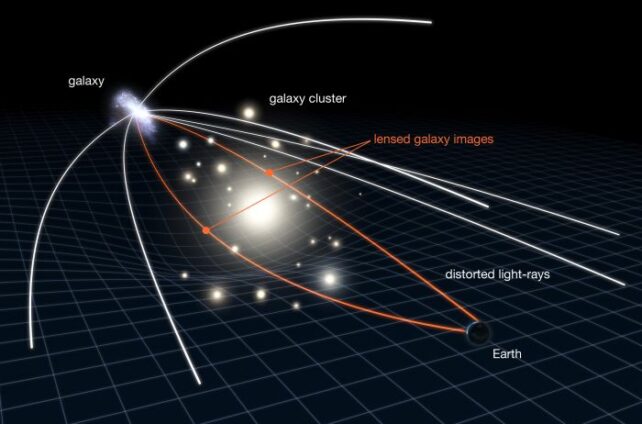In a galaxy hanging out in the early Universe less than 1.5 billion years after the Big Bang, the James Webb Space Telescope has made an astonishing detection.
From light that traveled for over 12 billion years from a galaxy known as SPT0418-47, astronomers teased out the spectral signal of complex molecules – the polycyclic aromatic hydrocarbons (PAHs) that make up some of the dust grains in the clouds that drift between the stars, soaking up the light and re-emitting it at infrared wavelengths.
This dust indicates a high rate of star formation, which isn't unexpected for a galaxy of this early Universe epoch. But the dust is not uniformly distributed, and that shows that this star formation can be mapped to different locations within the galaxy, according to a team led by astronomer Justin Spilker of Texas A&M University.
And the ability to make such a detailed observation of such a distant galaxy is honestly pretty danged mind-blowing.
"Here we present James Webb Space Telescope observations that detect the 3.3-micrometer PAH feature in a galaxy observed less than 1.5 billion years after the Big Bang. The high equivalent width of the PAH feature indicates that star formation, rather than black hole accretion, dominates infrared emission throughout the galaxy," the researchers write.
"Our observations demonstrate that differences in emission from PAH molecules and large dust grains are a complex result of localized processes within early galaxies."
Polycyclic aromatic hydrocarbons might sound high-falutin', but they're not particularly rare. Here on Earth, they're as common as soot. Because they're in soot. They're a class of organic compounds that contain a ring of carbon atoms that can form during the compression and heating of organic matter. Coal contains PAHs; so does smoke, smog, and crude oil.
The origins of PAHs can be non-biological, too; as far as we know, most of the PAHs in the Universe are non-biological. And there are a lot of them out there.
Previous analysis suggests around 15 percent of all carbon between the stars in galaxies like ours is bound up in PAHs. Most of that is floating between the stars as dust in the interstellar medium, and they're considered a fairly reliable tracer of star formation.
We've detected PAHs in other galaxies, but finding them in very faraway galaxies is much more challenging. These molecules absorb light and re-emit it in infrared wavelengths, and previous infrared telescopes had vastly limited sensitivity and coverage. However, we now have the JWST, the most powerful space telescope ever built, strongest in infrared wavelengths.

But that's not quite enough on its own. JWST had to tap into a quirk of physics to make such a detailed observation: gravitational lensing. This is a gravitational curvature of space-time that occurs around massive objects in the Universe. Imagine a bowling ball placed on a trampoline: The fabric of the trampoline warps and stretches in response to the mass.
Space-time does something similar around massive objects such as galaxies and galaxy clusters, but there's a bonus. Because space-time is warped and stretched, any light traveling through it also becomes warped, magnified, and sometimes duplicated. This means we can effectively use these lenses as a sort of cosmic magnifying glass, adding a lot of oomph to the power of our telescopes.
Between us and SPT0418-47 is another galaxy, at a distance of around 3 billion light-years, providing that lensing oomph. This means when JWST took observations of the galaxy as part of the TEMPLATES Early Release Science program, it was able to get enough detail that Spilker and his colleagues could tease out the spectral signature of the light emitted by PAHs at a mid-infrared wavelength of 3.3 micrometers.
This constitutes the most distant detection to date of complex aromatic molecules, and although there's a lot we still don't know – the reason for the uneven distribution of PAHs throughout the galaxy is unknown – it bodes excitingly well for future studies of the evolution of galaxies in the early Universe.
The research has been published in Nature.
